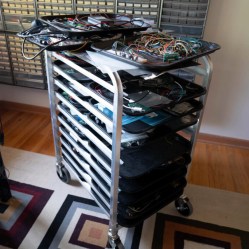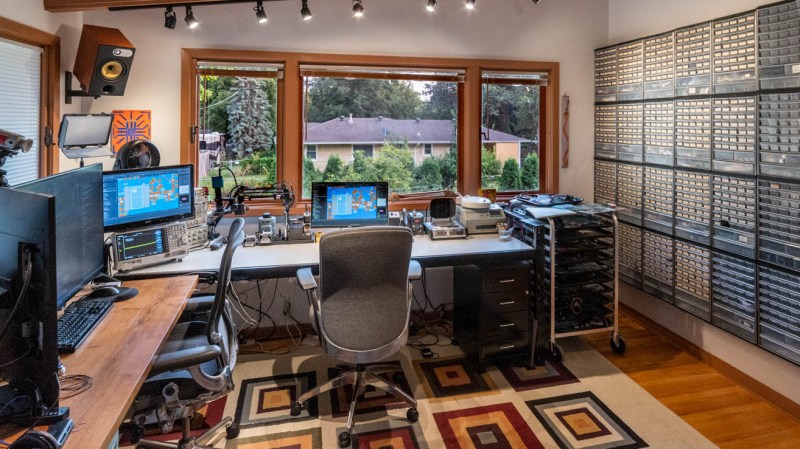[Jay Carlson] has shared some fantastic guidance on how to optimize one’s home workspace, and you just might want to emulate some of his layout, especially if you routinely juggle multiple projects. He makes the important point that different people have different needs, so one size does not fit all. Optimizing one’s workspace must first take into account what kind(s) of work one does, and many of his tips and tricks are pretty broadly applicable.

[Jay] works on embedded systems, and often switches between many different jobs and projects. Get your notepads ready, because there are plenty of great takeaways.
For example, to get a good top-down camera view of what’s on the workbench, he uses a camera mounted on an articulated arm (the kind that usually has a lamp attached to the end.) This makes the camera easy to deploy and easy to stow, and he can effortlessly save footage or share video with colleagues online.
Another great tip is using what most of us would call cafeteria trays and a matching rack. With each tray devoted to a different project or version of hardware, it makes switching between jobs as simple as sliding in one tray and pulling out another. It’s also a highly space-efficient way to store a lot of in-progress hardware. [Jay] gives a detailed walkthrough of his workspace and explains every decision, it’s well worth a read.
It’s always better to save space, as long as doing so doesn’t negatively impact the work itself. If you’re looking for space-saving tips, be sure to check out this tiny workshop’s space-saving hacks for more ideas.















1hr of work, 4hrs of youtube
Oh yesss, i’m not alone !!!!
I have looked for those tray-racks-on-wheels before but I didn’t know the correct name. I will look for bun racks now, thanks!
Also called bakery racks apparently (in the UK anyway).
the “correct name” will yield the correct price,when searching for used gear,just “stainless” will yield all kinds
of interesting bits of industrial grade stuff owned by people
who dont know the correct name or price or care.
also when scrap prices tank,then availibility goes up.
a few trips in a truck hauling scrap to a yard can be educational,vast piles of stainless ,aluminum,and steel made of things,much of which clearly had or has life left.
another candidate for repurposing is map cases,often in the form of cabinets or a table with many wide,deap, but very short drawers.
and plastic snap lid food containers and big heavy duty totes are game changers for storage space utilization.
I also modify the big snap handle totes, by filling the top
with expanding foam ,placing a piece of thin fitted plywood,on
the fresh foam,weighting it till the foam sets,makng a small tool to shape a cast in place silicone seal in the groove in the top,when done its a air tight tote that you can stand and work on.
In German (and in Dutch) they go by the name of Regalwagen (regaalwagen). Took ages to find that. Google translate yields Shelf Trolley.
My tip: an architect’s drawing cabinet. Steel drawers with magnetic dividers such as magnetic knife holders and magnetic screw trays to organise the drawers. Cabinet doubles as workbench.
Step 1: Have enough money to afford a setup like that.
Not to mention a huge amount of space… and a 2nd workshop in your huge basement…
At age 34…
well, he seems self employed.
About the saleae: take directly 16bits ones, 8 bits are mostly not enough and I had issues with non pro ones when working with low voltages MCU (1.8v).
Remember also that streaming analyser requires a beast PC for doing meaningful work, don’t try on less than 8GB PC otherwise it can becomes a world of pain when doing long captures.
Otherwise their support is top tier, they replaced a defective 16 bit pro without waiting for return in a few days.
Yeah, but due to higher prices of Saleae recently I would sugest to get DigiView DV518 Logic Analyzer, which is even better for half of the price.
Sadly it appears they don’t support linux. Bit of a deal-breaker for me.
Maybe somebody will add support for it to Sigrok?
My workSpace is 1.08 X 2.00 meter and I want to cry 😅
Trays, yay, happy to see something I’ve thought of on my own! I’ve had great success with ikea trays, can cram all kinds of projects/efforts/toolsets onto a tray, and stash it away – super handy!… but a bit expensive for how many of them I want to have – definitely would go for second-hand trays whenever available!
This wall full of component drawers is impressive and the rest of the workshop too. Wish i had the possibilities…
Never mind the rack. Look at that window! And those monitors, and the nice rug on the floor.
Very nice and I am certainly jealous.
I do have a bunch of map drawers as someone mentioned. They are great. Got them at auction when
the library decided they had a more clever way to store maps (or just decided to not store them).
All my hand tools on the office door, to which I affixed a pegboard, and bought a bunch of assorted pegs of eBay for a few quid.
As the door has a window, the pegboard is on hinges so I can get extra light in the afternoon when the sun swings round that way.
This one thing solved the “where did I put those cutters” problem (assuming I discipline myself to put them back…)
The cafeteria tray rack is a good start but don’t forget that there are “lug racks”/”lug carts” that are meant to hold cafeteria “bus tubs” – those grey things that restaurant workers use to clean dishes off tables.
The tubs themselves are available at a restaurant supply and you can build a rack out of lumber or whatever suits you to whatever dimensions work in your space. If you’re lucky, a metal one on wheels may turn up discarded somewhere, but with a little thought you can make a stable, sturdy rack with a sheet of plywood and some 1″ x 3″ stock.
Mine are full of everything from stock materials to boxes of fasteners to a lot of power tools that don’t have a home otherwise.
A small workspace with lots of projects is a challenge, Jay’s use of trays and a baker’s rack is spot on. We came up with a similar concept for storing projects and fixtures at work.
Started with bin storage also, but after time, bins are not space efficient for lots of small parts, like resistors, caps, semiconductors and hardware. For leaded (axial) resistors, poly snack zip bags marked with a Sharpie in 6in storage bins, sorted by value, holds the bulk of my resistors. For leaded semiconductors, small ‘coin’ envelopes in a 3in wide storage bins work nice. Each envelope has the part number and a pinout label. Hardware was also a problem and finally solved using Plano 3700 48 compartment boxes. One box can hold a complete M3 or 4-40 Pan and flat head assortment. Other boxes hold collections of M4,M5, 6-32 pan, flat, button head hardware.
Great post with lots of good things to consider. I was just thinking the other day that after two years, I figure it’s finally time to get around to putting together an at-home workstation myself.
I’d like to have a single desk that can host my work computer (all work and no play allowed on the work laptop), a daily driver, and also any retro/neo-retro (think RC2014) toys I want to play with.
I’m still trying to nail down exactly what I want, but at this point I know:
110v below and at desk level
5v, ditto
Widescreen hdmi monitor
4:3 lcd with vga/composite
usb ports galore
ethernet
some sort of instant-on serial terminal?
also various other 9 pin, ps/2, etc?
various video signal converters
I’ve realized that one of the main reasons I don’t play with my retro computers nearly as much is that I don’t want to pull out a compatible montirot, cables, etc. So my vague concept is sort of a ultimate KVM where I’d be able to plug in a random device and pull it up on a monitor, with a keyboard (assuming one isn’t built-in).
I’m actually considering some sort of patch panel arrangement, but it’s early stages yet.
Does anyone else experience this… not quite jealousy… frustration… almost gaslighting… I don’t know what the word is… seeing these predominantly American makers / youtubers etc. where they have all this stuff at home “only” in their garage or basement, when their garage or basement is bigger than a lot of European apartments, never mind being “spare” space.
Being neat and organised is no big deal at all when you have plenty of space and can just build whatever size workbench works best for you, throw as many storage racks/bins/boxes up on the wall as you need, etc. etc.
Space is a very scarce and valuable resource in a lot of places and is the single major constraint for a lot of us – it’s almost impossible to do much about and it massively impacts what we can & can’t do. I could super easily go out tomorrow and purchase a bridgeport mill, a full-size table saw, build myself a CNC plasma table and a big heavy duty welding bench, except that I would then need to spend maybe 200k+ to move to a bigger house with enough space to either have or at least have the prospect of building a garage or workshop big enough to put any of that in.
While the frustration can be a thing, it is important to recognize the influencers aren’t always doing what you are doing. It was a little easier to separate what was information from advertisement when the people presenting were in magazines or on TV. The New Yankee Workshop wasn’t real. It was power tool woodworking propaganda. The projects were still good, but the method could be unattainable for a lot of people. For many maker influencers, the making isn’t just a hobby it is a part or full-time job. The shop isn’t for weekend work it is a studio and industrial space.
As a woodworker that has moved a lot, I eventually came to the conclusion that, while the projects were cool, the tools and methods seen on YouTube were not compatible with my life. Workbenches were the first revelation. Most handtool workbenches are modeled after professional and factory benches from Europe that people worked at 8 to 12 hours a day. Once I realized the YouTubers and the majority of workers weren’t solving my problems, I started looking for traditions that did address my issues living in apartments.
For the more generalized maker, I would look at older DIY stuff. Popular Mechanics published a bunch of articles in the 50’s and 60’s on apartment shops and tidy work spaces that wouldn’t offend the wife. Adams Savage also did a video on th closet sized maker space he had for a while.
Yeah!
I think Mike’s workshop organization is much better and not so sterile as this guys “workshop” https://www.youtube.com/watch?v=xDVtrxvia20 :)
For small projects, I like to use a smaller tray (like an office clipboard, or cheap baking cookie trays from the dollar store) and store the “trays” in a stackable office in-box (https://www.amazon.com/Officemate-Achieva-Letter-Recycled-26212/dp/B0052L7KNC/ref=sr_1_16?crid=7U3RBUFF5DMG&keywords=stackable+mail+basket&qid=1645014014&sprefix=stackable+mail+basket%2Caps%2C40&sr=8-16). These will hold a Raspberry Pi, Arduino, or any other small board, along with a breadboard, and even a small power supply or battery pack. Nice and cheap.